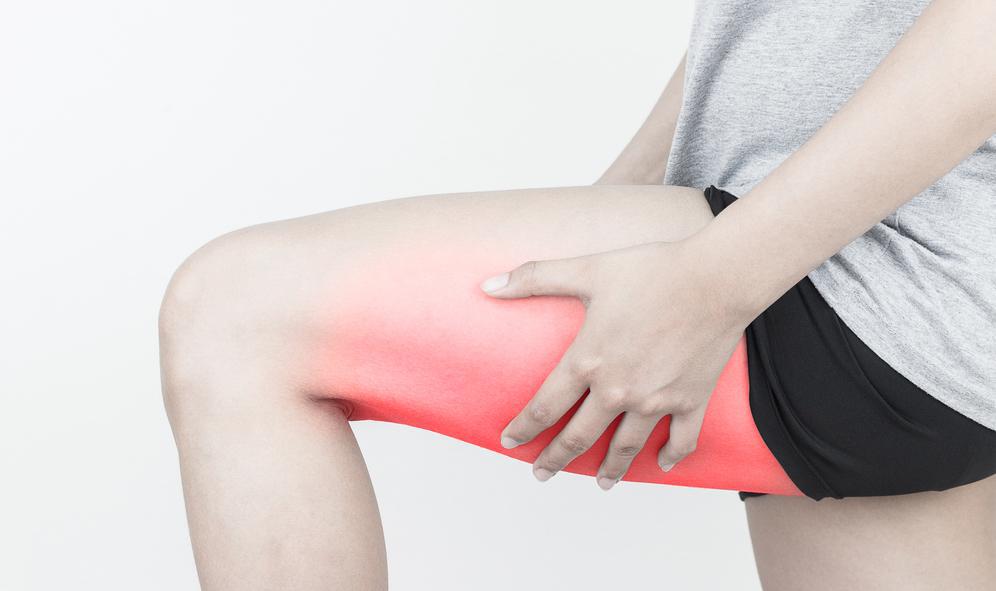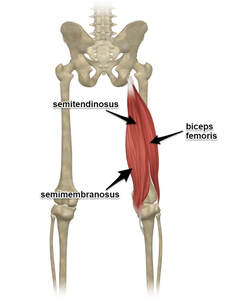|
It is commonly believed that hamstring injuries cause the biggest time loss and are one of the biggest detrimental factors to team performance. This is in the elite sport setting but hamstring injuries are also very common in amateur and community sport as well. Hamstring injuries also don't have to be on the sporting field. One of the biggest risk factors for getting a hamstring injury is previous hamstring injury, so prevention is always better than trying to treat a previous hamstring injury. If you have been unfortunate enough to have had a hamstring injury, don't worry there are still things we can do to lower your risk. What are the hamstrings and what is a hamstring injury? The hamstrings are a group of muscles that sit at the back of your thigh. There are three, Bicep Femoris, Semitendinosus and Semimembranosus. All three cross over the hip and knee joints and therefore all three contribute to both hip and knee function. Their two primary roles are to flex or bend the knee and extend the hip. A hamstring injury is when there is a tearing of the hamstring muscle fibres because of an excessive force or stretching is placed upon the muscle fibres. Hamstring strains happen in all different activities but the most common way to injure a hamstring muscle is while running, and more specifically in the end of the swing phase of the running gait. During this phase the hip is going into flexion and the knee is going into extension. The role of the hamstring during this phase is to control these two movements and contract while lengthening, this is called an eccentric contraction and if there is too much force or the muscle is fatigued then a strain or a tear can occur. Acute rehab phase Directly after a hamstring strain it is important to use the acronym PEACE & LOVE (Protect, Elevate, Avoid anti-inflammatories, Compression, Education & Load, Optimism, Vascularisation, Exercise). Read our blog on this topic to learn more. Allowing the hamstring injury to recover by protecting it and not applying unnecessary excessive force initially and then also using movement and appropriate loading early in rehabilitation is the key for the best outcomes. Maintaining some form of exercise is also key, just because you have a hamstring strain does not mean you can't exercise. A great exercise for optimal loading is the Hamstring Isometric Holds, you apply isometric ( contraction with no muscle length change) loading to the muscle which can help with pain management and you can find the optimal load to apply which can be changed as you progress. Below is the hamstring Isometric holds. Try holding for up to 5 times for up to 30s. Getting back to activities Activities like walking and slow running are great exercises for improving the function of your hamstrings early on and should be a focus for hamstring rehabilitation after the initial acute phase. Building up hamstring strength in the gym or at home with exercises is also important to make sure the hamstring builds its capacity back to what it needs to tolerate to avoid another injury. In my personal opinion this step is probably the most skipped and could be a reason for some hamstring re injuries. What not to do Along with any injury rehab there are always things to avoid to get the best outcome and in hamstring injuries this is passive stretching! Passive stretching is forcefully putting the hamstring on stretch and holding this position and if you remember from my explanation above this is effectively putting the hamstring in the same position as how it got injured. Of course we want to maintain the length and function of the hamstring however passively stretching is not going to help this. What to do to maintain function and length of the hamstrings! Let’s let the powers of human function, biomechanics and brain power help us out. With every hamstring contraction there is another muscle on the front of the leg the quadriceps which is lengthening. If the quads activate then the hamstrings lengthen and the brain allows and facilitates this. So for an Exercise that helps with maintaining the function and length of the hamstring while injured try performing active knee extension and flexion either in lying or a seated position. Here shown in the lying position. Try it just gently to begin with. Going from injury to strength. In order to get the best possible outcome for your hamstring recovery it is important that you can progressively load and expose the hamstring to different types of stimulus. Probably the most important action for any hamstring recovery is trying to increase the maximal force that can be applied during an eccentric contraction, just like the mechanism of a hamstring injury. Mid to late stage exercises to perform to get back to activities effectively are shown below. I would also add getting back to high speed running progressively is also very important!
This type of bridge is best done in mid stage rehabilitation to build up the hamstrings tolerance for load. Begin with a double leg and progress to single leg.
* probably best done with a partner holding your legs but here I have used a heavy object on my heels.
The Nordic Hamstring Curls apply force to an eccentric contraction and help build up the strength in this particular movement. These exercises can be progressed and regressed according to how hard they feel, and should be done consistently after you return to your activity to help lower your risk of another injury. Keeping the hamstrings strong is pivotal in keeping you hamstring injury free. Of course this is not a complete guide nor is it a program to follow but it does give you an insight in how you can go from injury to strength. If you would like a personalised injury prevention program or a hamstring rehabilitation program contact the clinic. Izaac Boylan Accredited Exercise Physiologist
0 Comments
|
AuthorSLisa Parkinson Archives
July 2024
Categories
All
|



 RSS Feed
RSS Feed